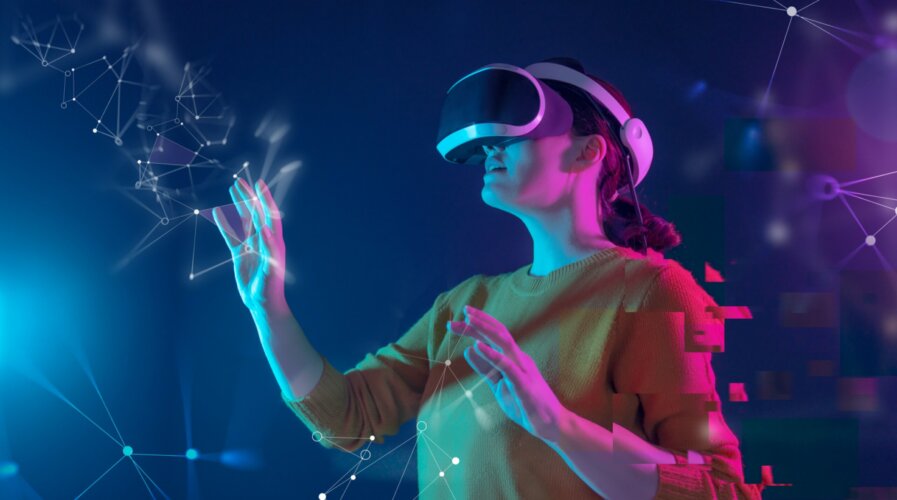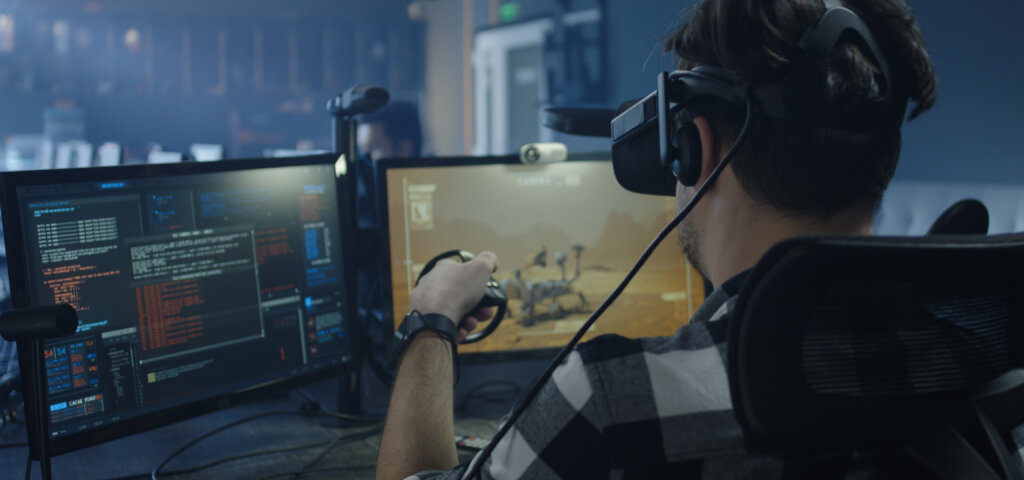
AI can be the game changer to revive the hype of the metaverse. (Source – Shutterstock)
Is the metaverse dead? How AI can build the ultimate experience
|
Getting your Trinity Audio player ready... |
- AI in the metaverse is speeding up content creation, making game worlds more dynamic, and tackling ethical issues.
- AI can help create truly individual gaming experiences, based on common coding.
- AI is not just a buzzword; it bridges the gap between 2D and 3D art to creating NPCs that “remember” player interactions.
In a digital landscape constantly reshaped by technological innovations, Artificial Intelligence (AI) stands out as a particularly transformative force in the game ecosystem of the metaverse—a compelling blend of virtual reality, augmented reality, and the internet. Here, innovators are discovering new avenues to bring their most out-there ideas to life.
Tech Wire Asia had an exclusive interview with Renz Chong, the CEO of BreederDAO. BreederDAO is at the cutting edge of integrating AI tools into the metaverse, enabling creators to build unique worlds and characters at an accelerated pace. Chong brings a wealth of insights into how AI reshapes creative processes, alters game dynamics, and even addresses ethical concerns within this burgeoning ecosystem.
In our conversation with Chong, he elaborates on how AI technologies like Midjourney are revolutionizing the creative process. These tools enable faster conceptualization, eliminate creative roadblocks, and make it easier for anyone to turn their visions into virtual realities.
Unlocking creative potential: AI tools in the metaverse
Chong identifies two primary avenues when asked about how AI tools are elevating the creative process for those seeking to craft unique characters and worlds in the metaverse. First, regardless of their knowledge or skillset, AI allows anyone to become a creator. People can now create characters, digital assets, in-game objects, avatars, and even games themselves without having the technical know-how that was previously necessary.
“This allows for the second way that AI is affecting the creative process in the metaverse, which is that AI makes the content creation cycle much faster,” Chong emphasizes. “Game designers who used to spend a lot of time creating mockups and demos can now use tools like Midjourney to create the initial layer.”

Renz Chong, the CEO of BreederDAO
Chong believes this is especially useful for conceptualizing and overcoming creative hurdles. AI can act as an instant “brainstorming partner,” helping to eliminate roadblocks on the creative journey. It also helps bring your vision to life more quickly and can even assist you in visualizing what you will create in the real world based on your imagination.
So, how does this development impact game designers and artists within the metaverse ecosystem? Before the age of AI, artists were siloed in their own areas of expertise. In other words, they couldn’t quickly transfer their creative skill sets to other mediums, says Chong.
Chong explains that AI can bridge the gap between 2D and 3D art, unlocking new creative possibilities. His company has developed AI Skins, a no-code tool that instantly transforms 2D prints into 3D NFTs. This tool allows for hundreds of design iterations and is compatible across various digital spaces, offering users expansive creative freedom.
AI can provide insights into various industries and burgeoning opportunities, says Chong. This can help you identify new avenues for creation and provide the context you need to work in unfamiliar domains. For instance, you could request an AI to generate a brief outlining the latest trends and essential factors in a specific industry, guiding your design and development process accordingly.
Of course, the key to creating an immersive and ‘connected’ metaverse environment is to ensure that everything around you feels engaging. This naturally leads to discussions about Non-player characters (NPCs), who have traditionally been bound by pre-programmed scripts. Chong understands that one of the most critical factors in effective game design is making gaming experiences feel unique and personalized.
AI-Driven NPCs will make gaming experiences more unique
Chong believes that AI-powered NPCs enhance gaming by making experiences more personalized and unique. These NPCs can remember details about players and have tailored conversations, creating a sense of individuality that taps into the same motivations that attract people to horoscopes.
When asked about the potential of AI in predicting and even setting player-NPC dynamics based on past interactions and whether they can ‘remember’ and ‘learn’ from previous encounters with players, Chong believes there is a lot of potential.
Learning and “remembering” are integral parts of many of the AI tools with which we interact regularly outside the gaming world, says Chong. For instance, ChatGPT can remember and learn from previous conversations you’ve had with it. It can even mimic your writing style or present information in a way that’s easy for you to understand.
“The same is true for NPCs. For instance, if you’re interacting with an NPC character who’s a merchant within the game you’re playing, it can remember the kinds of items you’re interested in purchasing and may even offer you special deals,” he explained.
“AI can also make NPCs that help enhance your gaming experience in other ways. For instance, in many of today’s games, NPCs and elements like ‘quest markers’ play an important role in guiding players through their journeys,” Chong added.
AI can help make these guide points more dynamic: you can ask it to remind you of tasks left undone or to provide you with certain kinds of information about what’s coming. For instance, you could tell an NPC to remind you that you need to complete five quests per day. So, when you are getting ready to sign out of the game, it could remind you that there’s still some work left to be done.
In a sense, AI-driven NPCs could potentially change how players strategize and make game decisions. But how this will affect game design principles and player behavior analytics requires an understanding of different types of players and their motivations within a game.
Chong explains that people love discovering hidden elements and creative layers in games, like “Easter Eggs.” AI-enhanced NPCs make these experiences more personalized by remembering details about the player. This sense of personalization resonates with players, in a similar way to the idea of horoscopes and zodiac signs. It makes them feel seen and unique in the game world.
For casual gamers seeking unique and fun experiences, AI can craft more dynamic, personalized quests. These players value exploration and wonder, “What unique journey can this game offer me?”
How AI changes the dynamics in a game
On the other hand, competitive players focus on winning and social recognition, like topping leaderboards or earning digital medals. For them, AI can make strategy more intricate and exciting, for instance by having an NPC that can be ‘fooled’ to avoid conflict for a period. These AI-enhanced elements offer a new layer of gameplay that appeals to the strategic thinking and social competitiveness of these players.
When integrating AI into any realm, ethical considerations are paramount. Chong believes that intellectual property rights are a significant ethical concern, especially when AI generates content. He sees blockchain as a solution for tracking the provenance of ideas, ensuring creators get proper credit.
“Ethical considerations aren’t the only challenge; keeping players continually engaged is another,” said Chong. He thinks AI can address this by enabling dynamic, ever-changing game environments. First, on the development side of things, AI makes developing games much faster – generative AI tech allows for faster content generation and automation of some game design processes.
Second, AI also supports the development of games that change and evolve based on how you interact with them. You can use AI to program specific virtual environments or characters to change based on sequences of events – so with just a handful of variables, you can create an almost infinite loop of possibilities where characters and environments are different each time someone plays the game.

Game developer can use AI to modify the game based on sequences of event. (Source – Shutterstock)
For instance, in an “endless dungeon” scenario, the environment could change every time a player interacts with a character. This dynamic keeps players engaged, always offering new challenges and experiences.
The future of game development: AI and personalization
The way AI has started to play a pivotal role in content creation raises questions about how the roles and responsibilities of game developers might shift. Essentially, AI can personalize experiences for any gamer. So it’s likely we’ll see game developers “niching down” in terms of the aesthetics they use to serve different markets, according to Chong.
For instance, a game built on a specific set of mechanics may have a cuter aesthetic for audiences in the East, and a more edgy, realistic appearance for players in the Western world.
“It may even become possible for developers to “copy and paste” the code that makes up a game and then use AI to generate many different looks, dialogue styles, and other “surface-level” elements depending on the users that they are targeting,” said Chong. “This would work in a similar way to how decentralized exchanges (DEXs) are copy-and-pasted in the world of digital assets – developers copy the code and then dress it up with a different appearance and perhaps some different features to suit different markets.”

AI has personalized the experiences of every gamer. (Source – Shutterstock)
For developers, gaining a general understanding of the technology that powers AI is perhaps most crucial. You’ll have an advantage if you’ve created a machine learning model.
It’s also really crucial to understand how AI will affect player motivations within games. Game developers have already accepted that AI-powered bots are inevitable in the gaming landscape. AI players are already topping leaderboards in some games – this has changed what matters to hardcore gamers – obviously, people want to be the best. But when you add the AI element into the equation, the “goalposts” change: an AI bot can become good enough to beat even the best human player if it trains long enough.
That said, future players may be more motivated by the level of personalization and curation that a particular game can offer.
“This is again why we’ve created AI Skins — to help players gain access to higher levels of creative self-expression and personalization within the games they play. We’ve also been working to make this technology more interoperable by consistently expanding the number of file formats (token standards) in which NFT wearables and other digital assets created with AI Skins are available. So anyone who wants to create with AI Skins will be able to do so in the file format compatible with the game or other virtual environment of their choice,” Chong concluded.
READ MORE
- Safer Automation: How Sophic and Firmus Succeeded in Malaysia with MDEC’s Support
- Privilege granted, not gained: Intelligent authorization for enhanced infrastructure productivity
- Low-Code produces the Proof-of-Possibilities
- New Wearables Enable Staff to Work Faster and Safer
- Experts weigh in on Oracle’s departure from adland






